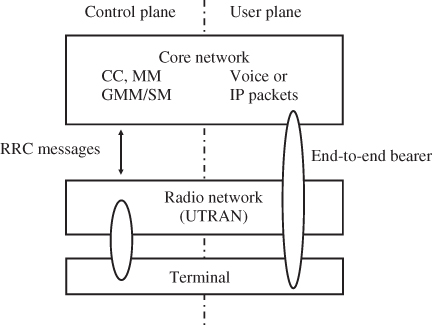3.4 UMTS Channel Structure on the Air Interface
3.4.1 User Plane and Control Plane
GSM, UMTS and other fixed and wireless communication systems differentiate between two kinds of data flows. In UMTS, these are referred to as two different planes. Data flowing in the user plane is data which is directly and transparently exchanged between the users of a connection like voice data or IP packets. The control plane is responsible for all signaling data that is exchanged between the users and the network. The control plane is thus used for signaling data to exchange messages for call establishment or messages, for example, for a location update. Figure 3.12 shows the separation of user and control planes as well as some examples for protocols that are used in the different planes.
Figure 3.12 User and control planes.

3.4.2 Common and Dedicated Channels
Both user plane data and control plane data is transferred over the UMTS air interface in so-called ‘channels’. Three different kinds of channels exist:
Dedicated channels: These channels transfer data for a single user. A dedicated channel is used, for example, for a voice connection, for IP packets between the user and the network or a location update message.
Common channels: The counterpart to a dedicated channel is a common channel. Data transferred in common channels is destined for all users of a cell. An example for this type ...
Get From GSM to LTE: An Introduction to Mobile Networks and Mobile Broadband now with the O’Reilly learning platform.
O’Reilly members experience books, live events, courses curated by job role, and more from O’Reilly and nearly 200 top publishers.

